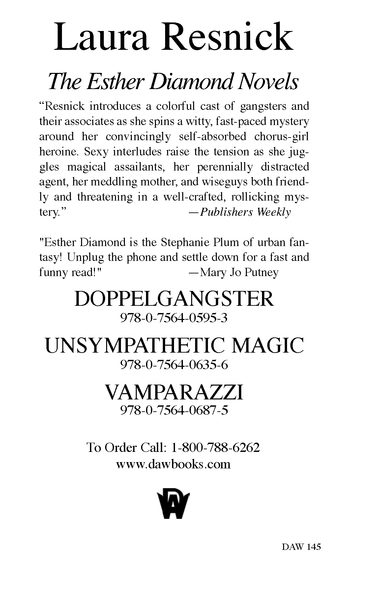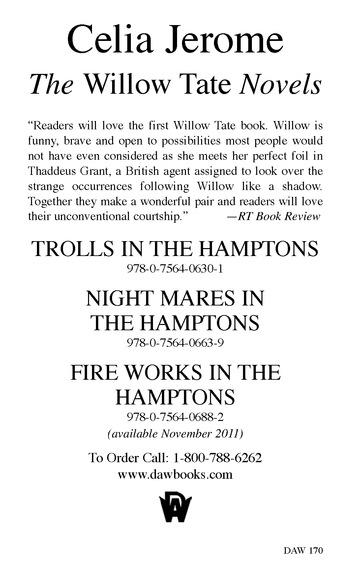Vamparazzi (50 page)
Authors: Laura Resnick

“Thank you,” Max said, touched.
“Yes, I would have liked to travel more,” Radvila repeated as the wind toyed with his gray hair. “One always thinks there will be more time, but the years pass so quickly. Life goes by and, before you know it, you're an old man, and the things you might do one day have become the things you never did.” He shook his head. “You're too young to understand this yet.”
“Oh, not really,” Max said, guiltily aware that he had already lived longer than Radvila, and that he would, if he continued surviving his adversaries, have many more yearsâperhaps centuries, for all he knewâto learn, to travel, and to enrich his life with new friendships. “I think I understand.”
“I have no regrets.” Radvila gazed reflectively at the setting sun. “I have a fine family and a good place in the world, and I was born a vampire. It's enough for one man.” He smiled. “But I would have liked to see Vienna.”
“Perhaps you shall,” Max replied. “Perhaps you will come visit me there.”
Radvila shook his head. “The time for that has passed. I have too many responsibilities at home, and I'll be gone from there until our work here is done and you return with a delegation to sign the treaty.” He added ruefully, “Also, I am getting old. This journey has been hard on me.”
“Perhaps it is nightly battling the undead which has been hard on you,” Max suggested.
“That, too,” Radvila agreed. “But I think this will be my last journey. And my last campaign against the undead. The time fast approaches for me to leave this work to those who are younger than I. My old bones are complaining about the physical conditions of a vampire hunter's life.”
“Even my bones are complaining,” Max said. “I am not sorry to bid farewell to my daysâand nightsâas a vampire hunter.”
“What will you do next? After we meet in Belgrade, that is. After this is all over.”
“I don't know,” Max said, surprised to realize he hadn't thought about the future yet. Ever since coming to Serbia, he had grown used to thinking he probably didn't have one.
“Perhaps you will do the traveling that I did not,” Radvila said, the alcohol on his breath evidently fueling an uncharacteristic bout of whimsy. “I believe you will venture farther than I ever dreamed of goingâfarther even than
you
dream.”
you
dream.”
“What makes you say that?” Max asked curiously.
“You seem like a man with a restless thirst for knowledge. As if you are on a quest to gain worldly wisdom.”
“I have my quest,” Max said. “Confronting Evil.”
“I can see into the future from this hilltop, too, you know.” Radvila nudged him with an elbow. “And I see that you will live long, help many people, and travel far. Who knows ... perhaps you shall even travel all the way to the New World one dayâwhose wonders even vampires in Vilnius have heard about.”
“The New World?” Max repeated with a smile, wondering just how much Radvila had been drinking. “That
is
far.”
is
far.”
“It's another place I would very much have liked to see, if I had more than just this one life to live.” Radvila said wistfully, “Think about it, Maximillian. The
New
World. How exciting that sounds!”
New
World. How exciting that sounds!”
“Yes.” Someday, perhaps ... Feeling a little whimsical, too, he asked, “Do you suppose they have Evil there?”
“Ah, my friend,” said the grizzled vampire. “I suspect they have Evil everywhere.”
Author's Note
The vampire epidemics of Eastern Europe in the eighteenth century are a documented historic event, though I have added fictional dimensions (i.e. actual vampires) in this novel. In reality, the problem was serious enough to require official government investigations just as, in this story, it requires the intervention of Dr. Maximillian Zadok and Lithuanian vampire hunters.
But why (I hear you ask) was there a sudden outbreak of rampant vampirism?
Actually, such incidents had probably been occurring for centuries in that region. But by the early eighteenth century, imperial wars and treaties resulted in the Ottoman Empire losing much of its Eastern European territory to the Habsburg monarchy of Austria. Upon hearing about vampire epidemics for the first time, a few years after taking over control of the region, the Austrian government's reaction was (I paraphrase): “Whoa, they're doing
what
in those provinces?” Followed by: “We need to send someone to investigate this and find out what's going on.”
what
in those provinces?” Followed by: “We need to send someone to investigate this and find out what's going on.”
Two particular vampire cases of that era created considerable interest in their time and are generally credited with introducing Eastern European vampire folklore to Western European culture: the separate and unrelated cases of Peter Plogojowitz and Arnod Paole. After each man died, in their respective Serbian villages of Kisilova and Medvegia, the local mortality rate increased. As a result, Plogojowitz and Paole were accused (in absentia) of being vampires and starting vampire epidemics. Panic and paranoia quickly spreadâas did gruesome antivampire activities.
In the early 1730s, the authorities who were assigned to investigate these incidents wrote detailed accounts of strange phenomena for which they had no explanation. And thus the folklore of Slavic villages took hold of the imagination of Western Europeâincluding that of Dr. John Polidori, who wrote “The Vampyre” almost a century later. However, Polidori's suavely seductive Lord Ruthven is wholly unlike the grotesque, mindless creatures of folkloreâthe same creatures which Max encountered during his sojourn as a vampire hunter.
So what really happened in Serbiaâand other provinces experiencing vampire outbreaksâall those years ago?
The two typical features of historical vampire epidemics were (1) a rash of mysterious deaths and (2) the exhumation of corpses that looked ruddy and well-fed, and which often had blood dribbling from their mouths.
Well, a wave of unexplained deaths in peasant villages wasn't actually mysterious if you consider the conditions in those communities. Disease was spreading through a vulnerable population that didn't understand epidemiology. Various fatal contagions, including the plague, were often blamed on vampires in the good old days. (For example, tuberculosis is considered the likely culprit of a vampire scare in New England in the nineteenth century.)
And the hysteria provoked by digging up plump, ruddy-looking corpses with bloody lips was based entirely on not understanding the stages of decomposition. As were all the other “classic” signs of vampirism, such as clawlike fingernails and strange noises coming from the corpses. What the living were seeing in those unearthed graves was, unbeknownst to them, the normal appearance of the decomposing dead. (For an explicit example, see a fascinating National Geographic documentary called
Forensic Vampires
. My fervent advice: Don't watch it while you're eating.)
Forensic Vampires
. My fervent advice: Don't watch it while you're eating.)
Moreover, even well-trained doctors (which some of the Austrian investigators were) in the eighteenth century had a level of medical knowledge that wouldn't earn them so much as a Boy Scout merit badge today. Although the written reports of the Austrian officials demonstrate an ability (and, indeed, a Teutonic determination) to observe, investigate, and record strange phenomena with precision and detachment, they simply didn't understand what they were encountering in their vampire investigations.
This misunderstanding of disease and decomposition was at the heart of Eastern European vampire folklore, and also at the heart of Western Europe's fascination with it for generations before novelist Bram Stoker created his own enduringly iconic version of the undead.
Meanwhile, on another subject, there are indeed miles of tunnels, drains, chambers, and interesting structures beneath the streets of New York City (though the tunnel which connects to the Hamburg is, like the theater itself, strictly an invention of this novel). In fact, I used to eat regularly at a Chinese restaurant in Manhattan wherein the bathroom was accessed via a tunnel that ran underneath the street.
I also once spent a night with a group of urban explorers in some of New York's most famous underground tunnels and chambers. I was invited out one evening (
I
thought we were going to dinner), and before I knew it, I was being outfitted with rubber boots and a headlamp, and walking through the Bronx's Van Cortlandt Park at night (which was just as stupid of me as you might suppose). Upon reaching our destination somewhere in the dark, we shimmied beneath a large, rusty metal door, via a wet gutter full of used syringes and entered the famous Croton Aqueduct, the abandoned underground tunnel system that was built in 1842 to supply Manhattan with water from upstate. We explored the tunnels and caverns most of the night, saw amazing wonders, and bumped into another group of explorers doing the same thing. It was one of the most unforgettable experiences of my life, and I knew then that someday I'd have to use New York's underground world in a book.
I
thought we were going to dinner), and before I knew it, I was being outfitted with rubber boots and a headlamp, and walking through the Bronx's Van Cortlandt Park at night (which was just as stupid of me as you might suppose). Upon reaching our destination somewhere in the dark, we shimmied beneath a large, rusty metal door, via a wet gutter full of used syringes and entered the famous Croton Aqueduct, the abandoned underground tunnel system that was built in 1842 to supply Manhattan with water from upstate. We explored the tunnels and caverns most of the night, saw amazing wonders, and bumped into another group of explorers doing the same thing. It was one of the most unforgettable experiences of my life, and I knew then that someday I'd have to use New York's underground world in a book.
To learn more about vampirism or urban exploration, check out the Research Library on my Web site at
www.LauraResnick.com
.
www.LauraResnick.com
.
Having survived vampires and vamparazzi, as well as sewage and other hazards, Esther Diamond, her friends, and her nemeses will return soon for their next misadventure in
Polterheist
.
Polterheist
.
âLaura Resnick




Also by Laura Resnick
DISAPPEARING NIGHTLY
DOPPELGANGSTER
UNSYMPATHETIC MAGIC
VAMPARAZZI
POLTERHEIST*
DOPPELGANGSTER
UNSYMPATHETIC MAGIC
VAMPARAZZI
POLTERHEIST*
Â
Â
Â
Â
Â
Â
Â
Â
*Coming soon from DAW Books
Other books
Rain of the Ghosts by Greg Weisman
The Billionaire Boys Club (Billionaire Romance Series Book 1) by Miller, Cara
Flight to Canada by Ishmael Reed
A Box of Gargoyles by Anne Nesbet
Blue: The LAPD and the Battle to Redeem American Policing by Joe Domanick
Black Hats by Patrick Culhane
Irish Aboard Titanic by Senan Molony
Double Black Diamond (Mercy Watts Mysteries) by A.W. Hartoin
Dinosaurs Before Dark by Mary Pope Osborne
